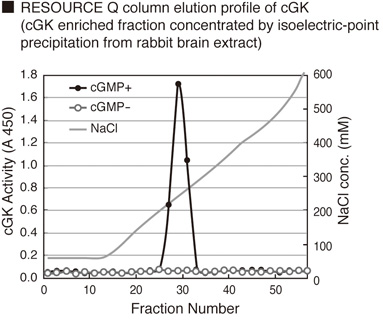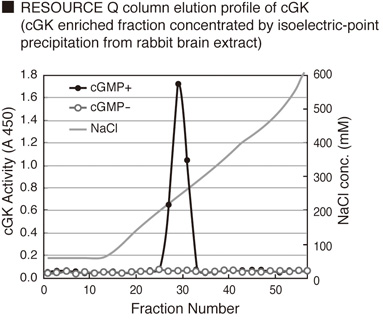CycLex Cyclic GMP dependent protein kinase (cGK) Assay Kit
| Code | Size | Price |
|---|
| MBL-CY-1161 | 96 Assays | £603.00 |
Quantity:
Prices exclude any Taxes / VAT
Overview
Regulatory Status: RUO
Shipping:
4°C
Storage:
4°C. Please refer to datasheet for additional information
Images
Documents
Further Information
Applications:
Other - 1) Monitoring the purification of cGK.
2) Screening inhibitors or activators of cGK.
3) Detecting the effects of pharmacological agents on cGK.
Background:
Nitric oxide (NO) and a broad spectrum of hormones, drugs, and toxins raise intracellular cGMP concentrations and thereby regulate a great variety of functions, including smooth muscle relaxation, neuronal excitability, and epithelial electrolyte transport. Pfeifer et al. (1996) noted that depending on the tissue, an increase in cGMP concentration leads to the activation of different receptors, such as cyclic nucleotide phosphodiesterases. The identification of the physiologic mediator of cGMP is complicated by the existence of 2 forms of cGMP-dependent protein kinase (cGK), types I and II, which are encoded by distinct genes. Smooth muscle, platelets, and cerebellum contain high concentrations of cGK-I, whereas cGK-II is highly concentrated in brain, lung, and intestinal mucosa. The function of cGK-II is not well understood, although there is evidence that it mediates intestinal secretion of water and electrolytes induced by the E. coli toxin STa and the intestinal peptide guanylin.
Activation of cyclic GMP-dependent protein kinase (cGK) is an important event in the regulation of blood pressure and platelet function. Upstream signals include the generation of nitric oxide (NO) by NO synthases and the subsequent rise in cGMP levels mediated by NO-dependent guanyl cyclases (GCs). The identification of new cGK activators by high throughput screening (HTS) may lead to the development of a novel class of therapeutics for the treatment of cardiovascular diseases.
Description:
The CycLex Research Product CycLex®Cyclic GMP dependent protein kinase (cGK) Assay kit is primarily designed to measure the activities of purified the cGK family of kinases for the rapid and sensitive evaluation of inhibitors or activators. The phospho-specific monoclonal antibody used in this assay kit has been demonstrated to recognize the phospho-threonine 68/119 residues on G-kinase substrate, which is phosphorylated by cGK family members. Additionally, column fractions of any cultured primary cell, cell line, or tissue homogenate can be assayed for cGK family activity with the CycLex Research Product cGK Assay kit if the appropriate dose of cGK specific inhibitor, e.g. (Rp)-8-pCPT-cGMPS.
Gene IDs:
Human: 5592 Mouse: 19091
Kit Components:
Microplate (coated with recombinant G-kinase substrate), 10?~Wash Buffer, Kinase Buffer, 20?~ATP, HRP conjugated Detection Antibody, Substrate Reagent, Stop Solution
Target:
cGKs
References
1. Pfeifer, A., Aszodi, A., Seidler, U., Ruth, P., Hofmann, F. and Fassler, R.: Intestinal secretory defects and dwarfism in mice lacking cGMP-dependent protein kinase II. Science 274: 2082-2084, 1996
2. Tamura, N., Itoh, H., Ogawa, Y., Nakagawa, O., Harada, M., Chun, T.-H., Suga, S., Yoshimasa, T. and Nakao, K.: cDNA cloning and gene expression of human type I-alpha cGMP-dependent protein kinase. Hypertension 27: 552-557, 1996
3. Orstavik, S., Natarajan, V., Tasken, K., Jahnsen, T. and Sandberg, M.: Characterization of the human gene encoding the type I-alpha and type I-beta cGMP-dependent protein kinase (PRKG1). Genomics 42: 311-318, 1997
4. Li, Z., Xi, X., Gu, M., Feil, R., Ye, R. D., Eigenthaler, M., Hofmann, F. and Du, X.: A stimulatory role for cGMP-dependent protein kinase in platelet activation. Cell 112: 77-86, 2003.
5. Yamahara K, Itoh H, Chun TH, Ogawa Y, Yamashita J, Sawada N, Fukunaga Y, Sone M, Yurugi-Kobayashi T, Miyashita K, Tsujimoto H, Kook H, Feil R, Garbers DL, Hofmann F, Nakao K.: Significance and therapeutic potential of the natriuretic peptides/cGMP/cGMP-dependent protein kinase pathway in vascular regeneration. Proc. Natl. Acad. Sci. U.S.A. 100(6):3404-9, 2003.




